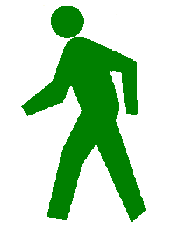Everyone Is A Pedestrian
 The Signs of Safety Are Everywhere
The Signs of Safety Are Everywhere
 The Signs of Safety Are Everywhere
The Signs of Safety Are Everywhere
Most motorists are very familiar with the meaning and intent of the numerous roadside safety signs which they see every day. Out of respect for the law and the safe movement of traffic, careful drivers have learned to appreciate and obey the messages which roadside signs convey. Speed limits, regulation of traffic movement as well as warning and route guidance are all important functions of highway signing; no motorist would feel secure venturing out on the highways without these safeguards.
We are all pedestrians at one time or another, and we are all bound to obey the traffic laws that assure the safety of all of us: motorist, bicyclist, and pedestrian. Far too many pedestrians, however, seem to ignore the very signals, signs and pavement markings which are installed to govern the movement of all traffic. These devices are not just for someone else who may be driving a motor vehicle. They apply to everyone.
In 1991, almost 5,880 pedestrians died and tens of thousands more were injured in traffic accidents. Sadly, it is a fact that young children and elderly pedestrians are more likely to be killed or injured in a traffic accident than any other group.
We should realize that no amount of signals, signs, or pavement markings will be able to protect a pedestrian who does not pay attention to these Signs of Safety all around us.
Pavement Markings Are Your Roadmap To A Safe Crossing
Crosswalks -- While they won't protect pedestrians from oncoming traffic, crosswalks do serve to guide pedestrians across the street. Motorists will be reminded to look out for pedestrians in the road when they see the bright, white lines of a crosswalk.
With Right-Turning Traffic at Intersections, Remember to See and Be Seen
Right Turn On Red -- Motorists drive under a lot of stress due to today's ever-increasing traffic. They often become impatient with all the slow-moving traffic. Right Turn On Red laws were passed in many States as a means to help move traffic through crowded intersections without adding new lanes.
Those intersections with a lot of pedestrian traffic usually have No Turn On Red signs which prohibit these turning movements.
At intersections where Right Turn On Red is permitted, the pedestrian must always be looking for turning vehicles before stepping off the curb. As they attempt to merge with moving traffic on the crossing street, drivers will usually be looking away from the corner and toward oncoming traffic. It's up to you in this case to be absolutely sure that any driver wishing to make a right turn sees you. If you're uncertain, just wait until the vehicle passes, then look again, and cross safely.
Don't take those NO RIGHT TURN ON RED signs for granted. Even when an intersection has these signs posted, you, as the pedestrian, should still make certain that motorists in the right turn lane see you. Don't step off the curb without checking! Motorists make mistakes too; don't compound their error by stepping out in front of a moving vehicle. Be patient.
A Reminder -- Be Visible After Dark
Night Time Visibility -- With the busy schedules that so many of us keep,
we often find ourselves going for a walk after dinner, when daylight starts to fade.
It's important to remember lessons we learned when we were young . . . about wearing
bright colors when walking at dusk or after dark. It's easy to carry a flashlight,
or to slip a reflective wristband on the arm facing traffic to let drivers know that
you're there! It may not make a fashion statement, but it will help you walk safely
when the sun goes down, and the headlights come on.
Publication No. FHWA-SA-93-058
HHS-11/8-93(20M)E
TFHRC Home | FHWA Home | Feedback United States Department of Transportation - Federal Highway Administration |